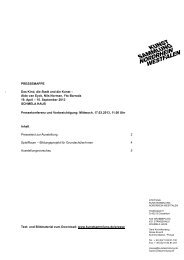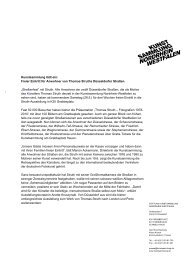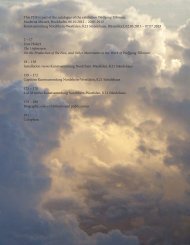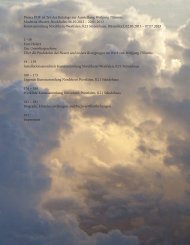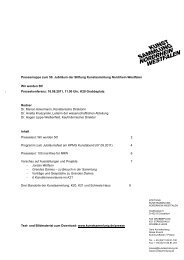Download online catalog (pdf)
Download online catalog (pdf)
Download online catalog (pdf)
You also want an ePaper? Increase the reach of your titles
YUMPU automatically turns print PDFs into web optimized ePapers that Google loves.
is not simply that of parts to a whole. Each side of this relationship exists despite the other.<br />
Pictures form sentences and statements without having any clearly identifiable semantic or<br />
narrative meaning, but rather as couplings of emotions, impressions and moods. However,<br />
the latter are entirely open to discussion, for the artist only provides a minimum of guidance.<br />
Besides clichés, he probably dreads nothing as much as didacticism.<br />
Continuity for Discontinuity<br />
Only on the rarest of occasions, such as in the period following the AIDS-related death of<br />
his partner Jochen Klein in 1997, have Tillmans’ energy and determination flagged for any<br />
length of time. Since 1993 he has produced picture after picture, exhibition after exhibition,<br />
book after book. In this year alone, in 2012, there are six major solo exhibitions for the public<br />
to attend – in Warsaw, São Paulo, Glasgow, Zurich, Stockholm and Bogotá; in addition to this<br />
there are the books Wolfgang Tillmans: Zachęta Ermutigung, Wolfgang Tillmans: FESPA Digital<br />
/ FRUIT LOGISTICA, Wolfgang Tillmans: Neue Welt, and the publication accompanying the<br />
survey exhibition at Moderna Museet and Kunstsammlung Nordrhein-Westfalen, which<br />
contains this text.<br />
This level of output bespeaks ability, skill, professionalism, aptitude; it seems like a<br />
singular manifestation of ableness. We search in vain for signs of failure, which is all the more<br />
astonishing considering the aesthetic importance to Tillmans of moments of hesitation, of<br />
precariousness, uncertainty, waiting, transience. A possible explanation: the artist’s professionalism<br />
is the prerequisite for emergence, for mistakes, for questioning and problematising, in<br />
other words, the productive weakness that paves the way for both crises and success. Tillmans’<br />
elaborate productions rely on efficient collaboration with institutions and publishing houses<br />
and on help from his own team of assistants and from his galleries. He is personally involved<br />
in and oversees each phase of the production process. A smooth-running, carefully controlled<br />
operation provides the necessary backdrop for the experimental openness, the surprises and<br />
spontaneity, the elegance and lightness that make his work what it is.<br />
In the programmatic afterword to his book Manual, published in 2007, Tillmans poses<br />
a series of questions which constitute the point of departure for his life’s work, but which also<br />
seem to underpin his art and to propel his artistic activities forwards: ‘When do developments<br />
become noticeable? When is a process recognizable? Which one achieves critical mass? When<br />
does something become something? What can pictures make visible?’ 33 Each of these questions<br />
is about marginal values, fault lines, turning points and flashes of intuition. Evidently it<br />
is not only individual exhibitions and individual books that serve Tillmans as his laboratory.<br />
The ongoing production of his œuvre as a whole is like a test series or a series of stress tests.<br />
Careful note is taken of whether anything happens or something changes, and under which<br />
circumstances. In these tests Tillmans uses tools that he himself has designed. Each individual<br />
picture fulfils a dual role – as both the means and object of observation and exploration.<br />
Discovering a Picture<br />
Wolfgang Tillmans and I are standing in one of the high-ceilinged, white-painted rooms of<br />
his studio, which occupies over six hundred square meters of one floor of an office building in<br />
Berlin-Kreuzberg that was planned and built as an apartment store in the late 1920s by Felix<br />
Hoffmann and Max Taut. It is one of his places of production. Here he and his team work on<br />
upcoming exhibitions, testing out ideas with cardboard models and trying out hangings on<br />
the walls; here, too, is the archive with the artist’s proofs – the operation centre for Tillmans’<br />
33 Wolfgang Tillmans, Manual (Cologne: Verlag der Buchhandlung Walther König, 2007), n.p.



